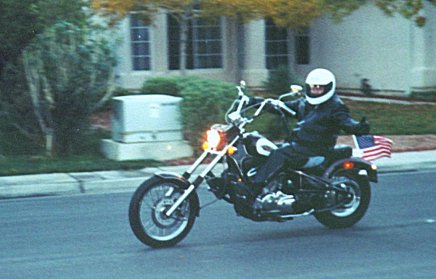 Customarily
Minded: July 2004 Customarily
Minded: July 2004 |
by Richard
Rose
Associate Editor
Beginner Bikes Magazine
 Chop
To It 2: The Next Cut Chop
To It 2: The Next Cut |
I
originally intended to have this up last month, but I couldn't
get it finished in time so I substituted an auxilliary article
I had drummed up in the past for a rainy day. Unfortunately, we
haven't seen a drop of rain for a few months out here in triple-digits
Southern Nevada, but nonetheless that deadline snuck up and hit
me like a hail storm.

So you ask, what more could I possibly write about the legendary
chopper mod that wasn't already covered last time around? A lot.
In May's
edition, I laid out seven ways to spend your weekend
and half your salary too. If you decided to take that challenge
and go forward with your chopper project, this article will serve
you well. In part one, I told you how to build it. Now I'm going
to tell you how to ride it.
 "It's
Just Another Bike. What Could Make It So Different?" "It's
Just Another Bike. What Could Make It So Different?" |
Other than the fact that you'd have to cross five state lines
just to find another one that even remotely resembles it? It doesn't
just look different, it handles different. I just can't stress
it enough that this is no beginner bike mod. Okay I have to take
that back, since I'm in the process of chopping a 250 Rebel it's
a beginner bike mod too. Let me rephrase that: This is no beginning
rider's mod. Get some road experience behind you, and lots of
it. In fact make sure you have properly outgrown that bike before
the transformation. That means master it. If you just recieved
your MSF certification, you'd be better served starting out on
a big Electra Glide or Gold Wing than starting off on a chopper.
I said it before and I'll say it again, choppers are to the cruiser
realm as 600+cc supersports are to the sportbike realm. You'd
better know what you're doing before throwing a leg over one and
thumbing the starter.
 Modified/Lowered
Suspension Modified/Lowered
Suspension  |
I've
touched on this topic in a past editorial, but here's a refresher.
Anytime you modify a motorcycle's suspension you're modifying
its handling traits. Lowering a bike does several things, including
reducing ground clearance and lean angle (lean angle is something
else I'll touch on again here). Any modifications that shorten
a shock will ultimately make the shock stiffer, or any lowering
kits will require a preload adjustment to make the ride stiffer.
A shock with a lowering kit that is left on standard preload
settings will bottom out easily, so stiffening it up is mandated
for a less harsh ride. With a lowered bike, you'll have to be
more wary of things like speed bumps in parking lots, as well
as driveways with steep drops and/or steep entrances. Since
a lot of the running gear will be closer to the ground, you'll
also have to be wary when leaning the bike in turns, as you'll
be scraping pegs or tailpipes sooner than you did at stock ride
heights. So you're going to have to slow it down a notch or
two in turns and curves. You may also have to adjust belt or
chain tension when lowering the rear of a motorcycle, so keep
this in mind before your first flight.
 Rigid/Hardtail
Handling Rigid/Hardtail
Handling  |
Some
chopper owners want the lowest possible seat height and will
make the ultimate sacrafices to get there in the name of style.
One of those sacrafices is rear suspension, sometimes knocking
off an inch or two just won't cut it so the entire rear suspension
gets shelved in favor of a much lower stance. Sometimes that
rear tire looks even sexier when it's stuffed up into that rear
fender, with just the rim showing below the fender lip. So if
you've decided to go the rigid route, this paragraph is for
you. Just like the suspension mods, the ride is going to be
a little stiffer with a hardtail. A lot stiffer. Motorcycle
Viagra couldn't make it any stiffer. Without the rear shock(s)
out back, you will feel every irregularity in the road along
the way, not just bumps and potholes but even seams, small rocks,
and the "road snakes" (those lines of filler material
that the road crews seal the cracks with). Bumps and potholes
will become your mortal enemies, and in that order. Hitting
large bumps at higher speeds can pitch the rear off the ground,
if you saw the Jesse James "Motorcycle Mania" where
he was riding to Sturgis one of the guys riding with him got
his tail airborn on a bump on the freeway. It's scary, and the
landings don't feel too good. Potholes are even worse, as you
drop down and crush your kidneys first, then you get pitched
into the air, and then you come back down to crush what's left
of your kidneys again. You really start to watch the road more
on a hardtail, and you'll learn to take only those streets you
are totally familiar with before venturing onto the less travelled
roads. I launched my hardtail once on a steep crest in an intersection,
let's just say I can appreciate why Robbie and Evel Kneivel
jumped bikes sporting suspension. And forget about lean angles,
with no rear suspension any irregularities you encounter on
the roads can cause your rear end to skip, skate, and pitch
in a curve or turn. Loss of traction at the rear wheel is not
a friendly thing in a curve. So if you're the type that always
tries to beat those yellow lights, don't try it in the left
turn lane on a hardtail. But fret not, there are two things
that you can do to a hardtail to improve the ride. First off
is an old school mod, let some air out of the rear tire. Your
sidewalls will flex and act as a "shock abosrber",
but be wary of rear fender clearance too, as when that tire
compresses on the ground side, all the air is forced up to the
topside and with very little fender clearance the tread will
scrub the fender...I wore a hole in my rear fender under the
pillion of my hardtail. Granted this mod serves to decrease
rear tire life, but you'll want some boinginess sooner or later
on a hardtail so it's inevitable. The other hardtail mod that
improves riding is carrying extra weight on the rear end. Yep,
who'da thunk it possible that adding a passenger could improve
a motorcycle's handling, but having that extra weight on the
rear can allow better handling in turns and curves, as the unsuspended
rear wheel is less prone to losing traction with more weight
on it. Weird but true.
 Additional
Wheelbase Additional
Wheelbase  |
Bikes
with longer wheelbases require more lean at given speeds. By
adding extra rake and longer forks (and rear lowering can even
add some extra wheelbase, re: belt/chain tension adjustment),
you will have a longer bike so both your overall length and
wheelbase will be affected. And so will your handling characteristics.
With additional wheelbase, the forks need to be turned a little
more in any given curve or turn, hence the bike will lean a
little more. Your turning radius increases with more wheelbase,
just like with automobiles. A sports car can make tighter turns
than an SUV, just like a Rebel can make tighter turns than an
OCC bike. You won't be able to lean the bike at the lesser angles
you were used to back when it was stock. If your stock bike
was sporting a 60" wheelbase before and you could take
a certain curve at 45mph at a mild 20º lean angle, your
lengthened wheelbase will demand a sharper lean (for ther sake
of comparison we'll estimate 25º in this scenario, each
curve and lean angle is different) to maintain that same speed
in that same turn. If that sharper lean angle is required, this
means you'll be bringing a lot of the running gear closer to
the ground, such as footpegs and tailpipes. Sound familiar?
I told you I'd say that again...which means that you'll have
to take those curves and turns at lower speeds than you used
to. So if your chopper is sporting both a lower squatty stance
along with extra wheelbase, now you have to be twice as aware.
Your days of canyon carving are over with a chopper.
 Got
Rake? Got
Rake?  |
Bikes
with substantially extra rake tend to have an anomally to their
steering. If you stand still and upright and rotate the forks
from side to side, the frame will dip and rise throughout this
maneuver, dipping down toward the ground as the forks get closer
to full lock position and rising again as they are centered
straight. Hence, braking becomes affected on a chopper. Forward
momentum can serve you wrong, as that momentum pushes the frame
down in front so the forks will try to flop over to their full
lock position as the frame presses down, so you have to be very
concious about braking. Don't lock that front tire up, as long
as that wheel is rolling you'll be able to brake safely, but
lock it up and that momentum comes into play. This is where
proficient riding comes in handy, and another reason why a chopper
is not a suitable beginner bike. Next up is the obvious, extra
space allowed for executing a U-turn. I touched on longer wheelbased
handling, and this really comes into play in a U-turn. Remember
the slow down principle? With a chopper you'll practically be
crawling through a U-turn, but with proper technique you can
still nail the inside lane farthest from the sidewalk, unless
you really went overboard on fork length. And parking the bike
can become a challenge in tighter quarters as well, with that
wider turning radius your chopper won't be as nimble in the
parking lots either so you'll have to make a few extra maneuvers
to make it fit in those tight spots.
In
summary, riding a chopper really isn't terribly different from
any other bike once you get to know it. They still react to counter-steering
like a stock bike would, but the main thing is to slow down for
those curves and turns and watch that front brake lever. As long
as you do the proper research into a chopper project, you'll still
end up with a fairly decent handling machine. I just can't stress
the research end enough, if you just start throwing things together
out of the blue your Franken-bike creation can easily bite back.
Get it right and get out and ride.
Chop
it and drop it down low, and keep that tin in the wind.
When Beginner
Bikes Associate Editor Richard Rose isn't crawling through U-turns,
he answers email at rich@beginnerbikes.com
[return
to the top]
|
 Bike
Of The Month Bike
Of The Month |

[click to
enlarge]
I said it before
and I'll say it again, it's not a beginning rider mod but that
doesn't mean you can't do it to your beginner bike. This month's
magnificent machine is a tribute to the chopper craze in a smaller
scale. This nifty 250 Virago sports all the cool chopper stuff,
from a generously raked front end to a killer set of upswept
pipes. The absence of a front fender is a tribute to old school
cool, and that slim-line seat cleans it up on the business end
of the bike. It's bad, it's black, it's dripping in chrome.
And it's clean, simple, and effective, just what a chopper should
be.
|

